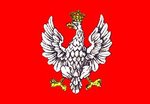Sanacja
|
|
Sanacja was a coalition political movement of the Second Polish Republic in the inter war years. It was created following in 1926 by Józef Piłsudski. It was a wide movement created to support "moral sanitation" of the society and the politics in Poland prior to and after the May Coup d'Etat of 1926.
History
Named after the Latin word for sanitation (sanatio), the movement was formed primarily by former military officers disgusted with the corrupt nature of Polish politics. It represented a coalition of members from the right, the left, and centrists. Its main focus was to eliminate corruption within Poland and to minimize inflation.
It appeared prior to the 1926 Coup d'Etat and lasted until the war, but it never was formalised. Since Piłsudski himself strongly opposed all political parties which he saw as promoting their own interests instead of supporting the state and its people, Sanacja never led to creation of a political party. Instead, in 1928 various Sanacja members took active part in creation of the Bezpartyjny Blok Współpracy z Rządem (Non-party Block for Cooperation with the Government), a bizarre coalition political party claiming not to be one.
Although Piłsudski never personally claimed the power, he had much influence over Polish politics after the Sanacja took the power in 1926. For the next decade, Piłsudski dominated Polish affairs as a strongman of a generally popular centrist regime. Military in character, the government of Kazimierz Bartel and all the following governments were unofficially accepted by Józef Piłsudski before they could be accepted by the president. Piłsudski mixed democratic and dictatorial elements while pursuing the sanacja, or national cleansing. Indeed, the internal stability was increased and thanks to the successful reforms by Eugeniusz Kwiatkowski the economical stagnation ended. However, at the same time Sanacja persecuted the communist parties, tried to limit the importance of the opposition by dividing them from the inside onto several factions.
In April 1935, shortly before Piłsudski's death, a new constitution was passed which supported all the main ideas of Sanacja: strong, centralised state with the presidential system of government. However, Piłsudski died soon after the new act was passed and sanacja faced several serious internal problems. Eventually it evolved into three separate movements:
- The Leftists (Lewica sanacyjna, formed around Walery Sławek), who sought some modus vivendi with the opposition,
- The Castle (Zamek, formed around the president Ignacy Mościcki who resided in the Warsaw Castle - hence the name), who later became the centre
- The Rightists (Prawica sanacyjna, formed around Edward Rydz-Śmigły) which soon became almost inseparable from the Camp of National Unity party.
The first of the groups soon lost much of its significance, but the other two continued the ideological struggle for the shape of the country until the war broke out. Many of Sanacja members were taken POW by the Germans during the Polish Campaign of 1939, others were evacuated to Romania where they stayed until the rest of the war or managed to reach France and Britain. Although France insisted on not including Sanacja in the Polish Government in Exile, many of them remained highly influential. After the war their forced exile was made permanent by the communist regime, which branded them as enemies of the state.
Notable participants
- Józef Beck
- Tadeusz Hołówko
- Janusz Jędrzejewicz
- Adam Koc
- Bogusław Miedziński
- Aleksander Prystor
- Walery Sławek
- Kazimierz Świtalski

